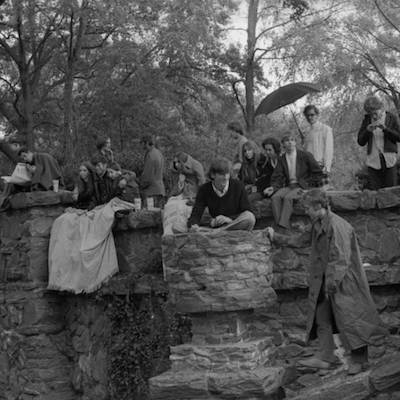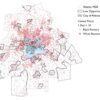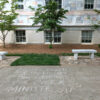In the summer of 1967, Atlanta Journal reporter Michael Palmer went undercover as a hippie.
Hoping to provide his readers with some insight into a movement that had recently made its way into the national consciousness, Palmer put on a “white, ruffled shirt, and old vest, levies [sic] frayed at the cuffs” and stealthily entered the city’s small but noticeable hippie community. In a series of articles that followed this experience, Palmer discussed with a mixture of dismissal and despair what he encountered during his five weeks of undercover research – from watching people take drugs in a “crash pad” to participating in a “love-in” at Piedmont Park. While Palmer ultimately provided little real insight into the countercultural mindset, he did make his readers very aware that something new and different was happening in Midtown Atlanta.1During the late 1960s and early 1970s the section of the city that straddled Peachtree Street for several blocks, running from roughly Seventeenth Street down to Tenth Street, served as Atlanta’s own version of San Francisco’s famed Haight-Ashbury district. This part of Midtown had acquired several names over the years2 – Tight Squeeze, the 10th Street Business District and the 14th Street Area – but became popularly known as “the Strip” during its countercultural heyday.3
The area had already developed a reputation as a bohemian destination by the early 1960s – one reporter described it as “Atlanta’s own Greenwich Village” – due to its proximity to the Atlanta College of Art and the Atlanta Memorial Arts Center, as well as its abundance of affordable housing for young adults moving to the city.4
By the middle of the decade a small community of hippies found a spiritual home with the opening of the Catacombs coffeehouse on Fourteenth Street. The area’s “hip” population – which included not only “real” hippies but also political radicals, members of motorcycle gangs, left-leaning religious leaders, artists, teenage runaways, drug dealers, sympathetic lawyers, social workers, business owners, and teenage “plastic hippies,” who visited the Strip on the weekends but then returned to their suburban homes on Sunday evenings – grew significantly in 1967 as the counterculture gained national recognition and thousands of curious teenagers and young adults made their way to hippie neighborhoods across the nation during the Summer of Love.
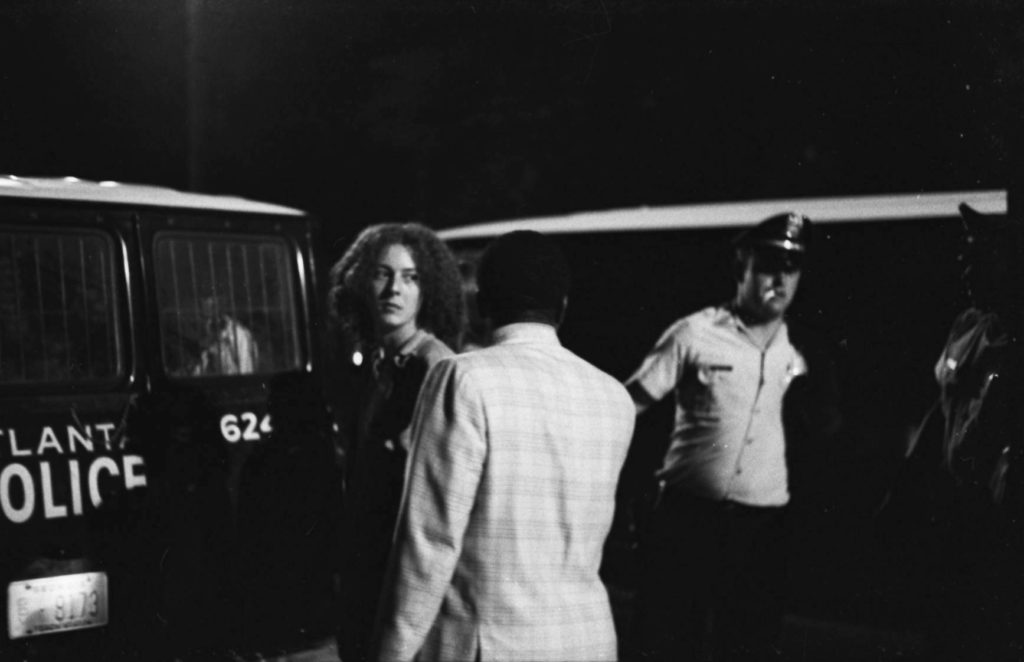
Several factors, however, thwarted attempts by Strip residents to create a thriving and safe hip community in Atlanta.5 Business owners disliked them, local “straight” residents complained repeatedly to city officials about their presence, and the police engaged in an ongoing campaign of harassment that included arresting hippies for minor infractions.
In July, 1968, a group of local business owners attended a meeting of the city’s Aldermanic Police Committee to complain how the hippie presence harmed the value of their businesses and made it “unsafe for residents to walk down the street.” That same month, Police Chief Herbert Jenkins launched a crackdown on the area’s hippie population.6 While the city’s recently founded underground newspaper, the Great Speckled Bird, regularly reported on the ill-treatment the hip community suffered at the hands of business owners and the police, the straight press routinely ignored or downplayed these issues.7
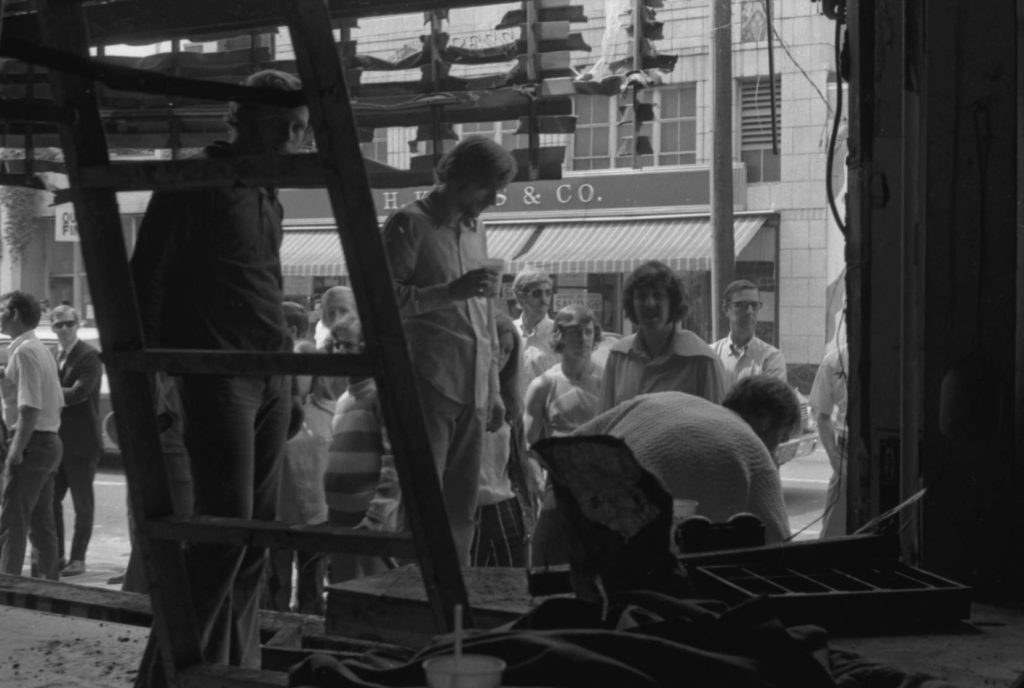
These issues worsened considerably during the first six months of 1969. The Great Speckled Bird speculated that a recent wave of suspicious fires in the area was an attempt to scare away hippies.8 In addition, the number of sexual assaults against hip women in the Strip increased, as did the number of physical confrontations between Strip residents and straight locals, some of which included the exchange of gunfire.9 In August, a near riot erupted in the Strip when hippies and political radicals clashed with local police and agents from the Georgia Bureau of Investigation during yet another in a series of drug raids in the neighborhood.10 Then, in early September, a firebomb destroyed Atlantis Rising, a combination artist collective and recreation center that served Strip residents and acted as a meeting space for radical political groups.11 Finally, this pattern of confrontation and violence culminated on September 21 when attendees and police clashed during a free concert in Piedmont Park.
The events leading up to and following the Piedmont Park riot illustrate the changing nature of social and political life in Atlanta during the late 1960s. Far from an isolated incident, the riot, and the response to it, reflected the growing frustration of Strip residents as they faced continual police harassment and acts of anonymous violence while trying to create a functional alternative district built on the concepts of cooperation and community. Moreover, the riot revealed connections and shared concerns between white youth and the African American community at a time of significant change in the local political landscape. While the Piedmont Park riot is a lesser-known event of civil disobedience in the history of Atlanta, re-examining the riot reveals how far the political and cultural radicalism of the 1960s had made its way into the nation’s most conservative areas, as well as how the presence of a community of radical white youth impacted local political scene, which is usually portrayed by historians of the era as a struggle between conservative whites and African Americans for control of the city during a time of significant demographic change.
Our Park
By the late 1960s, Piedmont Park, located just a few blocks east of the Strip, offered a safe haven away from the hassles of life on Peachtree. At a time when hippies were routinely arrested for simply walking down the street, the existence of a place where they could gather freely ensured that the park became integral to community-building efforts by local counterculture and New Left leaders. The Atlanta antiwar movement often chose the park as a gathering point for marches into downtown or as a location for post-march rallies.12 And in July 1968, approximately 800 people gathered around the park’s pavilion for the city’s first “Be-In,” an event copied from the more famous San Francisco Human Be-In held the previous summer.13 The hip community’s use of Piedmont Park increased significantly during the first nine months of 1969. In March, the Great Speckled Bird celebrated its first anniversary with a party in the park. The city’s political activists even took time to enjoy the park’s athletic facilities by forming a “Revolutionary Softball League” that spring.14 And the series of free Sunday concerts which had occurred occasionally during the spring and early summer of 1969 became more regular occurrences following the 1969 Atlanta International Pop Festival. The festival, held over the Fourth of July holiday weekend at an automobile racetrack in Hampton, Georgia, featured Janis Joplin, Joe Cocker, Credence Clearwater Revival, Grand Funk Railroad, and Led Zeppelin.15
Held the day after the festival ended, a free concert in Piedmont Park featured many of the bands that had played at Hampton, including, Delaney and Bonnie, Spirit, the Allman Brothers, and the Grateful Dead.16

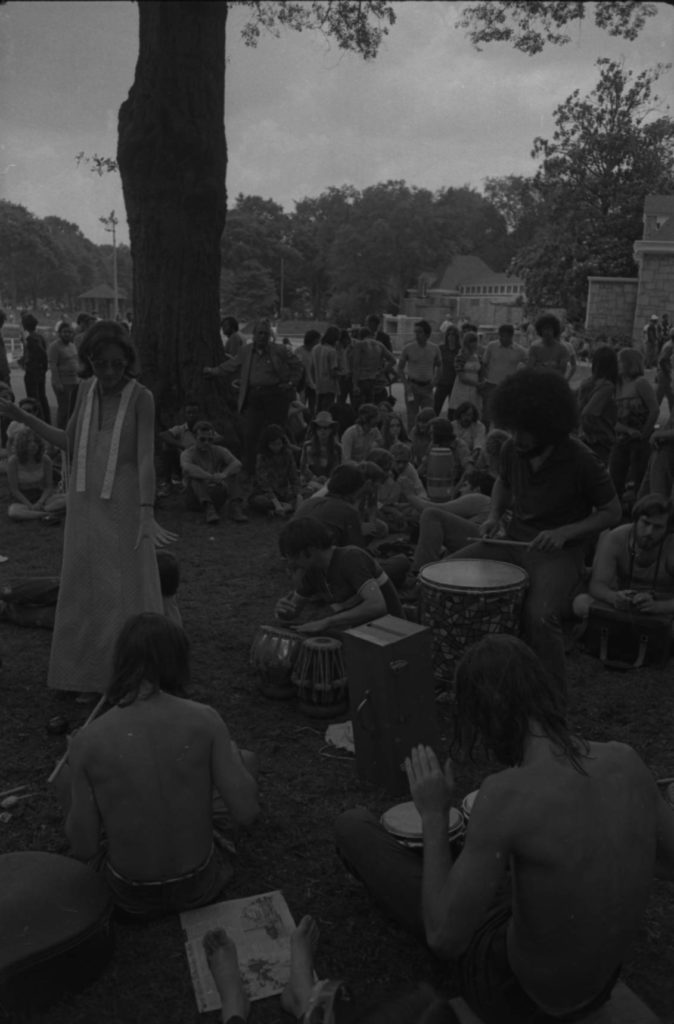
While the park served as key place to experience countercultural entertainment, the recent wave of harassment and violence in the Strip also led many hippies and New Leftists alike to see their use of the park in more overtly political terms; it had become an important battleground in their quest for meaningful social change.17 This shared cause between the counterculture and New Left was not unique to Atlanta in the late 1960s. While the middle years of the decade witnessed the rise of two movements that could be identified as uniquely separate, each with its own goals and philosophies, by 1969 the boundaries between the New Left and counterculture had become blurry. The New Left recast itself into an expansive social movement aimed at the creation of a new American culture as it sought more than just political change, while the counterculture rethought its earlier utopianism and now sought to practice its core beliefs within, rather than separate from, American society.18Echoing countercultural writers around the nation, the Bird had repeatedly expounded on the importance of rock music as a catalyst for social change and on Piedmont Park’s new role as a site for this melding of culture and politics.19
In a piece entitled “Our Park,” “Richard” explained the importance not only of rock music to the creation of a new society, but of a place to experience such music in a revolutionary way, noting that:20By the summer of 1969, the importance of Piedmont Park to the growth of Atlanta’s hip community led many Strip residents to consider the park, at least on certain days, as their own. Piedmont Park became a place to listen to some good music, get a free meal, commune with likeminded individuals, discuss radical politics, and explore new ways of living together. Or as “Richard” concluded,21Following the dramatic firebombing of Atlantis Rising in late August, the park also became a place of spiritual rejuvenation for the Strip community. On the Sunday following the attack, a benefit concert for the store was held in the park that featured several prominent local and regional bands, including the Allman Brothers. As Miller Francis, the community’s preeminent cultural chronicler, noted in an article for The Great Speckled Bird the concert was more than simply a musical event or a rally for Atlantis Rising. For Francis, the park acted not simply as a public recreational space, but as a key focal point for the political struggle to build a viable alternative community.22 Accordingly, as he noted:23
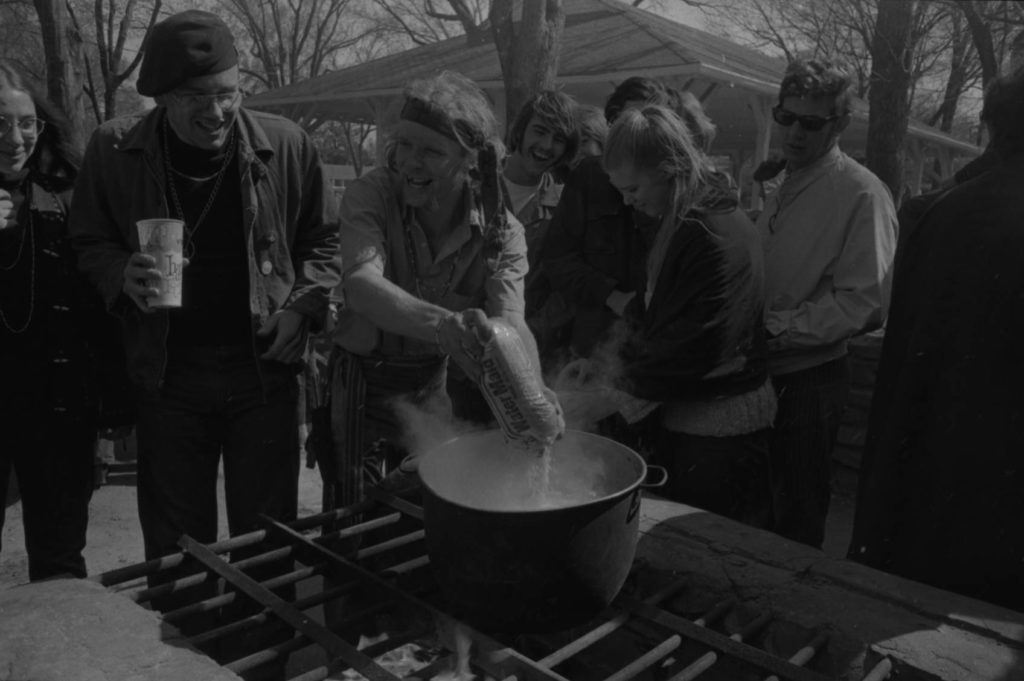
“The vibes in Piedmont Park on all the Saturdays and Sundays flow out of our fight to replace the power behind the firebomb . . . that gutted Atlantis Rising, and our attempt to design a politics to effect that replacement.”Francis noted the intense sense of positive feelings that the crowd in “our park” generated, as well as the wide array of the city’s population which was in attendance in addition to the usual hippie contingent, including “straight, crewcut, turned-on, tribal, black, working class, mothers and children.”24 However, it would be this very attachment to the park that laid the foundation for the riot that occurred only a week later.Throughout the nation, public spaces played an important role in bringing politics and culture together. Parks took on particular meaning in the late 1960s, serving as a central site for the expression of a spatial politics that helped reveal the growing intersection of the counterculture and the New Left. Perhaps most famously, in May 1969, violence erupted in Berkeley over an undeveloped piece of land owned by the University of California. Claiming the space as their own, over two hundred hippies, college students, and community activists had turned the former parking lot into a park, which they called “People’s Park.” Then, on May 15, police cleared the park and encircled it with cyclone fencing, a provocation which the local hip community responded to by rioting with the ensuing street battle ending that evening only after twenty policemen had been injured and twenty protestors had been shot, one fatally.25 While the events in Berkeley are well-remembered, the events at Piedmont Park a few months later exemplify that the willingness to defend contested space was not restricted to cities famous for their radical communities.
“Get the Pigs Out of Our Park!”
The September 21, 1969, free concert in Piedmont Park boasted an impressive lineup. While the Allman Brothers would not play that Sunday, the show presented some of the best local rock acts, including Radar, the Booger Band, and headliner The Hampton Grease Band. This list of performers, as well as the success of the concert the previous Sunday, and a prominently placed announcement in the Great Speckled Bird, ensured a sizable attendance. And despite a chilly rain, by late afternoon between 1,000 and 1,500 people had arrived in the park.


Several staff members from the Great Speckled Bird circulated through the crowd, collecting affidavits regarding police harassment, which they planned to include as part of the paper’s recently-filed lawsuit against the police department.26 Earlier that month the hip community became involved in a local debate over police brutality. During a speech at the West Hunter Street Baptist Church on September 12, DeWitt Smith, an African American patrolman, publicly accused several white officers of beating three black prisoners without provocation. Notably, during his comments, he also mentioned the mistreatment local hippies routinely endured, stating:27 During the following week, a coalition of local civil rights groups and the Great Speckled Bird filed separate lawsuits against the Atlanta police department, which illustrated an emergent, if problematic, alliance of the New Left, the counterculture, and the local civil rights movement in late 1960s Atlanta.28
But in addition to the Bird staffers, several undercover policemen also moved through the crowd in the park that day. And just as the band Brickwall started its set, word began to circulate that undercover narcotics agents from the Atlanta police were in the audience and looking to make arrests. Concert attendee George Nikas soon found himself in custody after following Detective C. R. Price through the crowd, warning other concertgoers that Price was a policeman. As the young man was led away a crowd gathered around the two and began chanting “show us your badge!” and “let him go!” In the ensuing confrontation, Price ended up pulling his service weapon and brandishing it at the crowd, providing enough of a distraction for Nikas to escape and disappear back into the audience.29
As the music, which had stopped during the struggle, resumed, Price and several other policemen moved back into the crowd and quickly found, and again apprehended, Nikas. This time, they also arrested Bill Fibben, a staff photographer for the Bird. But several hundred audience members immediately surrounded the cars containing Nikas and Fibben, shouting “This is our park!” and “get the pigs out of our park!” In response, police called for reinforcements and tear gas canisters. The concert’s promoter attempted to persuade police to let him restore calm but before he could do so, an officer lobbed a tear gas canister into the crowd and what had been merely an angry confrontation between the police and the concertgoers turned into a riot.30
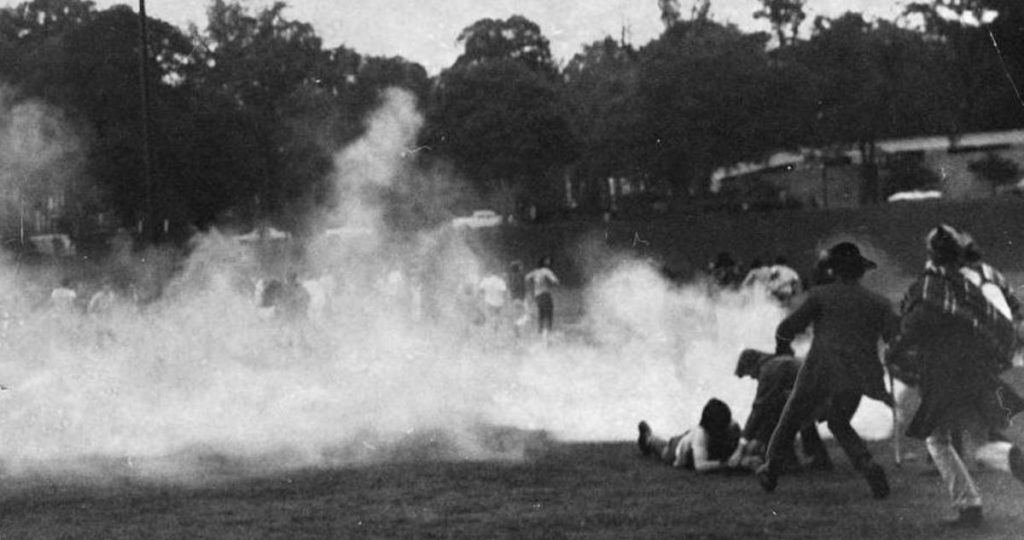
As the protestors around the patrol car began to scatter, several paddy wagons and almost the entire evening watch of the Atlanta police force approached the park. For the next thirty minutes a running battle of sorts took place. The police, who had taken up a position not far from the park pavilion, fired tear gas canisters into the crowd while several officers repeatedly charged into the rioters. The crowd responded by throwing some of the tear gas canisters back, along with rocks, cans and glass bottles, quickly dispersing after each volley only to retake its position after the clouds of tear gas dissipated.31 Ultimately, the confrontation ended only after American Civil Liberties Union lawyer Al Horn arrived at the park and talked with Police Superintendent Oscar Jordan.32 Following this conversation, the crowd calmed down and several police officers left the park. As attempts were being made to restart the music, Police Chief Herbert Jenkins and Mayor Ivan Allen finally arrived, too late to make any meaningful contribution although the mayor did spend some time speaking with concertgoers.33
Responses to the Riot
While the Piedmont Park riot resulted in few injuries and only twelve arrests,34 it provoked a variety of responses from the Strip community, civil rights leaders, local politicians, and city officials. The statements issued by these groups reveal the complicated nature of Atlanta politics in the late 1960s as well as divisions within the city’s hip community. Moreover, the cooperation between the hip and civil rights communities in response to the riot revealed how disaffected groups in Atlanta could cross racial lines when they found common cause.
With the mayoral election just weeks away, several of the candidates weighed in on the riot. City alderman Everett Millican, who had recently proposed a park curfew, favored drastic action, promising that, if elected, he would “run the hippies out of town.”35 Echoing statements he had made the previous spring, he labeled the city’s countercultural district “a disgrace,” filled with “hippies, homosexual, sex deviates and drug pushers.”36 While admitting that Piedmont Park had deteriorated before the hippies claimed it as their own, he still argued that “it’s gone down a lot more since.”37 Alderman and mayoral candidate Rodney Cook took a less aggressive position, stating that law-abiding citizens should not fear being “hit over the head” by police but that those who broke the law should be punished to the fullest extent possible. Instead of running the hippies out of town, Cook believed that hiring more policemen, raising salaries, providing them with better training, and creating neighborhood patrols would solve the problem.38
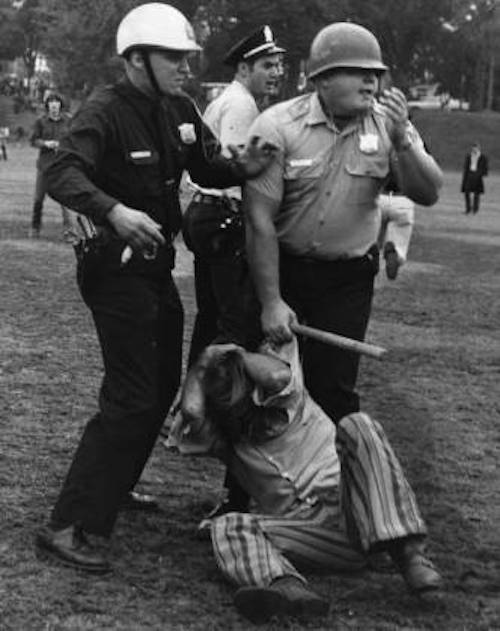

Meanwhile, in stark contrast to the interpretation of the riot offered by members of the political establishment, Great Speckled Bird writer Greg Gregory analyzed the riot from a countercultural perspective, arguing for the park’s importance to the development of a new American society and declaring that,
Sunday’s resistance was not ‘revolutionary antics,’ the work of ‘agitators.’ Sunday was a defense of the kind of life we have chosen to live. This life includes music; it includes dope; but more significantly; and of revolutionary impact, is our self-perception as a people acting in unity.
A park cannot be liberated by permit, cannot be ‘free’ just because freaks come together to dig some fine music . . . Sunday was about what comes down when . . . we transgress the constricted lifestyle that is acceptable to and in this rotten society.39
But Gregory also had harsh words for members in the hip community who criticized those who had fought back against the police. Arguing that this criticism attacked the very unity the riot had created, Gregory suggested that “to fall back on a love-and-peace stance which quickly becomes a hate-the-bottle throwers posture is to fragment the solidarity that saw politicos and culture freaks standing side by side.”40 While praising the importance of gentleness to their cultural revolution, he nonetheless argued that cruelty, not gentleness, needed to be the appropriate response when “tribal celebrations” came under attack. As he saw it, solidarity required that musicians, “trippers,” and rock throwers stand together or the new culture they hoped to create would die. Likewise, Jim Gwin asserted that “we must defend our vision as it emerges in concrete form. The communal/music experience in Piedmont Park is that vision.”41
The politicos of the Great Speckled Bird also responded quickly to the riot. Staff members at the Bird office began immediately collecting the statements of approximately one hundred people present in the park during the confrontation, which would be added to the police harassment suit the Bird had filed recently in federal court.42 During a press conference held at the newspaper’s office the day after the riot, the hip community presented three demands: that all charges against those arrested on Sunday be dropped, that all plainclothesmen and other policemen be banned from the park and, finally, to “let us have our music.”43
The riot also generated support from the city’s civil rights community. On Monday, the Atlanta Ad Hoc Committee on Law Enforcement and the Community, which had come together the previous April to investigate police brutality and included members of the Urban League, the National Association for the Advancement of Colored People, and the Metropolitan Atlanta Summit Leadership Conference, presented four recommendations to Mayor Ivan Allen. The committee called for an end to harassment, suspensions of policemen accused of brutality, improved jail conditions, and the establishment of grievance procedures. The group also noted that the Atlanta police “showed the same brutal force as Chicago” in their efforts to disperse the park crowd, a reference to the previous year’s street riots during the Democratic National Convention.44
While Allen declined to comment on these recommendations, he stated that the city would undertake a “full investigation of police brutality charges” stemming from the riot, and announced that the two officers noted most prominently for their actions in the park, C. R. Price and D. L. Dingee, had been transferred to duty in south Fulton County. Both the mayor and Jenkins stated this might help the situation since the problem had been caused only by a small number of “bad apples” within the police force.45The committee clearly saw common cause between black Atlantans and the Strip community when it came to law enforcement issues. In its statement to Allen, it claimed that “the city has evaded responsibility and accountability for abuse of its citizens. Brutality occurs not only at the jail, it happens at the time of arrests . . . and we know that the police rioted in Piedmont Park yesterday.”46 Likewise, Southern Christian Leadership Conference (SCLC) leader Hosea Williams articulated the connection between oppressed African Americans and hip community members. When speaking to the crowd at Piedmont Park after the riot, he told them that,47
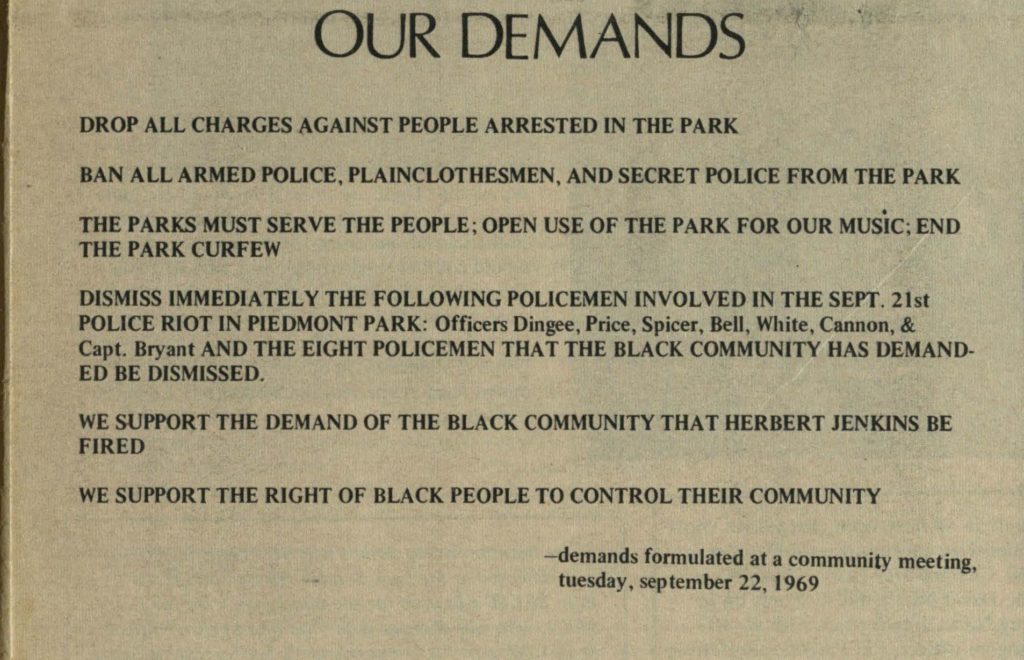
The Strip and civil rights communities further strengthened their bonds in the wake of the riot by planning a march to police headquarters at a meeting that included representatives from the Bird and the SCLC alongside numerous hippies and street people, ministers from several local churches, local countercultural shopkeepers, and political radicals. In addition to the three demands formulated immediately after the riot, the group agreed to publicly support the call from civil rights groups for the termination of Police Chief Herbert Jenkins and the demand that African Americans control their own communities. Attendees also demanded the firing of seven police officers involved in the riot, including Price and Dingee, as well as eight other officers that the African American community wanted dismissed.On Saturday, September 27, a procession of approximately 600 marchers – which would ultimately grow to 1,000 participants – left Piedmont Park headed downtown along the city’s main thoroughfare. Holding banners with the phrases “Fire Jenkins” and “No Armed Police or Narks in Park,” the group included several African American ministers and civil rights leaders, such as the Reverend Douglas Slappey of the African Methodist Episcopal Church, and Hosea Williams. Once they reached police headquarters the marchers handed over their demands to Superintendent Jordan and the crowd listened to several speeches, before turning around and heading back to the park.48

Where Did All the Hippies Go?
The riot and the series of confrontations that led up to it would ultimately garner national attention via an October 10 story in Time magazine, entitled “The Great Hippie Hunt,” in which it was suggested that,
police and state solicitor general’s agents, with the tacit approval of the city administration and Atlanta’s business community, have waged war against these so-called undesirables, treating them as the greatest threat to the city since General Sherman.49
This coverage and the brief flurry of activity following the riot in Piedmont Park ultimately did little to change conditions for the better, either in the Strip or at the park. Indeed, while the Strip had drawn most of the city leaders’ attention up to that point, in the years after the riot, they would increasingly object to the presence of the hip community in Piedmont Park as well, which many Atlantans had given up using after the hip community had adopted it as its own in 1969. Moreover, due to increased police harassment and the passage of a new city loitering ordinance in 1970,50 large numbers of people who had formerly called the Strip home had moved several blocks east to Piedmont Park.
Reports in local papers claimed that at least several hundred people now called the park home and in August 1971 the Bird reported: “the Strip is practically deserted and the park is being used more.”51 But the introduction of hard drugs, the growing presence of criminal elements – including violent bikers – and a serious problem regarding teenage runaways changed the nature of the community and provoked a set of responses from the new Mayor Sam Massell that would ultimately end the hips’ occupation of the park and spell the end of Atlanta’s hip community.
After a series of shootings in the summer and fall of 1971, Mayor Massell announced that a “special police detail, a mobile precinct, and a mounted patrol” would soon be on duty in Piedmont Park because, as he described it, “the park is a big place but not big enough to house punks with knives, guns, and needles.”52
These additional policeman soon began patrolling Piedmont Park aggressively and the crackdown had its intended effect – within days, hips had largely abandoned the park. New regulations which were soon adopted also made it harder to organize the kind of events that the hip community had held in Piedmont Park over the past several years, such as rock concerts, political rallies, and antiwar demonstrations.53 Denied the ability to organize events, hips still attempted to congregate informally in the park. Not surprisingly, the police worked diligently to make them unwelcome by selectively enforcing park ordinance 22-38, which made it “unlawful for any person, in any park, to, stand, walk, or ride on the grass,” and by asking for identification from members of any group of six or more hips. As the Bird put it, a “police state” now existed in the park.54
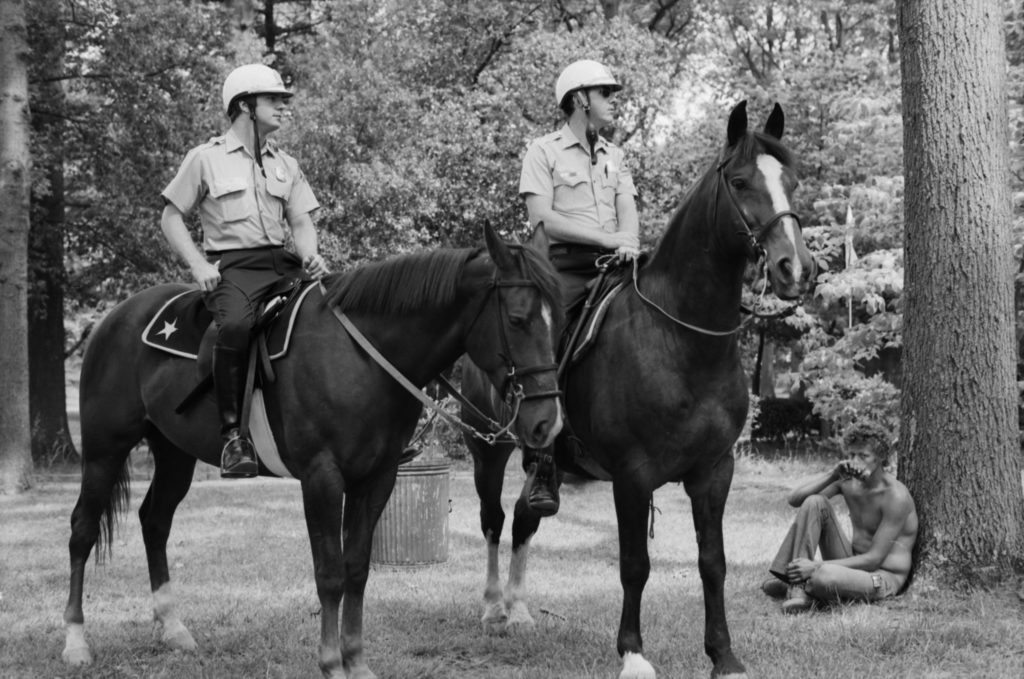
Pushed out of Piedmont Park and the Strip, the hip community saw its demise approaching quickly over the horizon. As its members relocated to other neighborhoods, left town, or moved on to new pursuits and passions, mainstream society’s adoption of many countercultural elements in the first years of the 1970s diminished the need for separate spaces where people could freely practice alternate lifestyles. Smoking marijuana, growing long hair, or just generally letting your freak flag fly no longer seemed so threatening, as witnessed by the newfound presence of “shaggy-haired young business executives in downtown Atlanta.”55 As the hippies disappeared, the developers moved in.

Over the next several decades, the coffeehouses, clubs, and crash pads of the Strip were plowed under, replaced by gleaming high-rise office buildings. Piedmont Park, however, remained largely unchanged and stands today as one of the few remaining physical spaces connected to Atlanta’s hip community. This seems appropriate, given the importance of the park to the city’s hippies and political radicals. Although the riot that occurred in September 1969 is perhaps the best remembered event of Atlanta’s freak past, in truth it was one among many that briefly helped turn Piedmont Park into a park for the people.
Cover Image Attribution: This work is licensed under a Creative Commons Attribution-NonCommercial-NoDerivatives 4.0 International License. Attribution must provide author name, article title, Atlanta Studies, date of publication, and a link to this page. Note that this license applies only to the text of the article, not to media used here by permission.
Citation: Huff, Christopher A.. “Parks are for the People: The Piedmont Park Riot and the Politics of Late 1960s Atlanta.” Atlanta Studies. August 21, 2018. https://doi.org/10.18737/atls20180821.
Christopher Huff is an assistant professor of history at Beacon College in Leesburg, FL where he teaches a wide variety of courses related to American cultural and social history after the Second World War.
Notes
- Michael A. Palmer, “How You Join the Hippies,” Atlanta Journal, October 22, 1967, 18A, and “Hippie Attends a Love-In, The Flower Children’s Pet,” Atlanta Journal, October 23, 1967, 1A, 9A.[↩]
- For more on the area’s various historical place-names and their significance, see: Jessica Keys, “Power and Place-Names: The Struggle For a New Urban Order in Midtown, 1870–1970,” Atlanta Studies, January 25, 2018, https://atlantastudies.org/power-and-place-naming-the-struggle-for-a-new-urban-order-in-midtown-1870-1970/.[↩]
- I have employed the term “Strip” to describe the neighborhood because the term has come to represent the hip community’s presence in Midtown during the late 1960s and early 1970s. When people discussed the Strip from the mid-1970s onward, they did not mean to discuss just a section of Peachtree Street or the businesses there that catered to hips. When people asked the question “what happened to the Strip?,” they more accurately meant to ask “what happened to the hip community that occupied that part of Atlanta?” Or to put it another way, “Where did all the hippies go?” and “What happened to the Strip?” exist as interchangeable queries in Atlanta.[↩]
- Bob Willimon, “Atlanta’s Own Greenwich Village,” Sunday Times Observer, May 27, 1962, 10.[↩]
- This essay will refer to the counterculture population of the Strip as the “hip community” as the term “hip” more accurately reflects the wide variety of people who saw themselves as part of a community allied against mainstream society.[↩]
- Police Committee Minutes, Regular Meeting, July 31, 1968, Box 63, Sam Massell Papers, Kenan Research Center, Atlanta, GA; Raleigh Bryans, “Alderman Order Hippie Crackdown,” Atlanta Journal, August 1, 1968, B4.[↩]
- While the coverage of Atlanta’s hip community by the Atlanta Journal and Atlanta Constitution was not particularly confrontational, it was also not supportive. These two papers did generally under-report events related to the New Left and counterculture. Demonstrations were often not reported on or if they were, crowd estimates were often on the low side in comparison to what was reported in the underground press. This was not particular to Atlanta but seen in other cities around the nation in the 1960s.[↩]
- Maude, “Fire!” Great Speckled Bird 2, no. 18 (July 14, 1969), 5.[↩]
- Lee Simowitz, “Atlanta’s Hippie Area Plagued,” Atlanta Journal, July 27, 1969, E1; Bob Goodman, “Bad Vibes,” Great Speckled Bird 2, no. 9 (May 12, 1969), 3, 17; Duane Beck, “Interim Report of the Fourteenth Street Area,” Box 1, Community Council of the Atlanta Area records, Stuart A. Rose Manuscript, Archives, and Rare Book Library, Emory University.[↩]
- Jack Nelson, “Hippie Community in Atlanta Angered by Police Tactics,” Washington Post, August 7, 1969, F3; Keeler McCartney, “Police Seize 75 Hippies in a Near Riot,” Atlanta Constitution, August 5, 1969, A1, 8.[↩]
- “Fire Bomb Suspected in Hippie Store Blaze,” Atlanta Journal, September 11, 1969, C4; Diane Thomas, “Fire Bombs Ruin Hippies’ Co-Op,” A6; Tom Coffin, “Atlantis,” Great Speckled Bird 2, no. 28 (September 22, 1969), 2.[↩]
- For example, on April 27, 1968, a march organized by the Atlanta Alliance for Peace proceeded from the federal building at Eighth and Peachtree up the city’s main thoroughfare and, after turning right on to Fourteenth Street, entered Piedmont Park for a rally that featured several plays by a local guerilla theatre group and a speech by former Students for a Democratic Society president Carl Oglesby. See: Howard Romaine, “Atlanta on the March,” Great Speckled Bird 1, no. 5 (May 10, 1968), 2, 15.[↩]
- Tom Coffin and Howard Romaine, “BE-IN: Hippies VS Cops,” Great Speckled Bird 1, no. 10 (July 19, 1968), 9.[↩]
- “Sports Section,” Great Speckled Bird 2, no. 9 (May 12, 1969), 3.[↩]
- Jim Gwin, untitled, Great Speckled Bird 2, no. 18 (July 14, 1969), 2, 3.[↩]
- Jim Gwin, untitled, Great Speckled Bird 2, no. 18 (July 14, 1969), 2, 3; Patrick Edmondson, “A Bus Stops in Piedmont Park, July 7, 1969,” The Strip Project, February 20, 2014, http://www.thestripproject.com/a-bus-stops-in-piedmont-park-july-7-1969/; the Grateful Dead’s set from that concert is available at “Grateful Dead Live at Piedmont Park on 1969-07-07,” Internet Archive, April 23, 2014, https://archive.org/details/gd69-07-07.sbd.clugston.3116.sbeok.shnf/gd69-07-07d2t01.shn.[↩]
- Bob Malone, “Community Self Defense,” Great Speckled Bird 2, no. 17 (July 7, 1969), 9.[↩]
- Doug Rossinow, The Politics of Authenticity: Liberalism, Christianity, and the New Left in America (New York: Columbia University Press, 1998), 247-248.[↩]
- While some rock bands, such as Detroit’s MC5, discussed politics openly in its lyrics, rock’s larger revolutionary role “lay in the purported ability of rock to expose the sham of Western culture and to change the life orientation, political or otherwise, of its listeners,” Timothy Miller, The Hippies and American Values (Knoxville: University of Tennessee Press, 1991), 77.[↩]
- Richard, “People’s Parks: Ours-Atlanta,” The Great Speckled Bird 2, no. 15 (June 23, 1969), 4.[↩]
- Ibid.[↩]
- Miller Francis, Jr., “Our Park,” Great Speckled Bird 2, no. 28 (September 22, 1969): 12, 13.[↩]
- Ibid.[↩]
- Ibid.[↩]
- For more on People’s Park in Berkeley see: W. R. Rorabaugh, Berkeley at War: The 1960s (New York: Oxford University Press, 1989), 155–66; Jim Gwin, “From Occupied Berkeley,” Great Speckled Bird 2, no. 11 (May 26, 1969): 3, 17.[↩]
- Bob Malone, “Police Harassment Bird Suit,” Great Speckled Bird 2, no. 29 (September 29, 1969): 18.[↩]
- Bob Rohrer, “Board Hints at Brutality Investigation,” Atlanta Constitution, September 13, 1969, A5.[↩]
- On September 19, a coalition of civil rights groups filed a lawsuit in US District Court that, among other demands, called for the removal of Police Chief Herbert Jenkins. See: Margaret Hurst, “Oust Jenkins, Suit Demands,” Atlanta Constitution, September 20, 1969, A 1. Earlier the same week, lawyers representing the Great Speckled Bird also filed suit in federal court, launching a “broad-based attack on the harassment and intimidation that the city has leveled at the community in recent months.” See: Bob Malone, “Bird Files Suit Against City,” Great Speckled Bird 2, no. 28 (September 22, 1969), 2. While the lawsuits indicate some level of cooperation and shared concern between the African American and hip communities regarding police brutality, the fact that they were filed separately points to a belief that each community had problems unique to itself. The fact that Mayor Ivan Allen agreed to meet with a bi-racial committee following the riot in Piedmont Park but not with a group of African Americans the previous week highlighted these differences as well as the challenges of building a bi-racial movement in Atlanta. See: Howard Romaine, “Black and White,” Great Speckled Bird 2, no. 29 (September 29, 1969), 6.[↩]
- George Nikas, interviewed by the Strip Project, available online at “George Nikas Interview,” The Strip Project, April 19, 2014, http://www.thestripproject.com/george-nikas-interview/; Frank Wells and Bob Hurt, “Piedmont Concert Erupts into Disturbance, 20 Held,” Atlanta Constitution, September 22, 1969, A1, A17; Hugh Nations and Harmon Perry, “Piedmont Park Melee ‘Looked Like WWII,’” Atlanta Journal, September 22, 1969, A1, A8; Gwin, “In OUR Park,” Great Speckled Bird 2, no. 29 (September 29, 1969), 3, 4.[↩]
- Ibid.[↩]
- Ibid.[↩]
- Al Horn was a legend in the Atlanta legal community. A criminal defense lawyer with a background in labor relations, during the late 1960s he took up the task of defending the local New Left and counterculture regarding a variety of issues, primarily those related to drug possession and police harassment. He advised the community on legal issues in preparation for the lawsuit filed on September 19 by the Great Speckled Bird. This relationship explains why Horn played a role in negotiating with police during the riot. See Bob Malone, “Community Self Defense,” Great Speckled Bird 2, no. 17 (July 7, 1969), 9.[↩]
- “George Nikas Interview”; Wells and Hurt, “Piedmont Concert Erupts,” A1, A17; Hugh Nations and Harmon Perry, “Piedmont Park Melee ‘Looked Like WWII,’” Atlanta Journal, September 22, 1969, A1, A8; Gwin, “In OUR Park,” Great Speckled Bird Vol. II no. 29 (September 29, 1969), 3, 4.[↩]
- Two police officers were treated and released for minor cuts and scratches at nearby Grady Hospital. The only person in the crowd whose injuries required more intensive hospital treatment was a forty-one-year-old mother who went to the concert to check on her two children but ended up being struck on the head with a policeman’s nightstick and getting thrown in a paddy wagon. See: Sam Hopkins, “City to Probe Charges of Brutality in Piedmont Park,” Atlanta Constitution, September 23, 1969, A1, A8; “Professor’s Wife Held for Court,” Atlanta Journal, November 5, 1969, B11.[↩]
- Alex Coffin, “Run Hippies Out: Millican,” Atlanta Constitution, September 22, 1969, B2.[↩]
- Ibid.[↩]
- Ibid.[↩]
- Alex Coffin, “Millican, Cook Talk on Brutality, Hippies,” Atlanta Constitution, September 27, 1969, A1, A8.[↩]
- Greg Gregory, “Sunday in the Park,” Great Speckled Bird 2, no. 29 (September 29, 1969), 2.[↩]
- Ibid.[↩]
- Gwin, “In OUR Park,” 4.[↩]
- Gwin, “In OUR Park,” 4; Nations and Perry, “Piedmont Park Melee,” A8.[↩]
- Nations and Perry, “Piedmont Park Melee,” A8.[↩]
- During the 1968 Democratic National Convention in Chicago, demonstrators and the police battled for control of Lincoln Park. For more on events in Chicago see Todd Gitlin, The Sixties: Years of Hope, Days of Rage (New York: Bantam, 1987), 326–31; Tom Hayden, Reunion: A Memoir (New York: Random House, 1988), 291–326; Mark Kurlansky, 1968: The Year That Rocked the World (New York: Ballantine, 2004), 269–86.[↩]
- Hopkins, “City to Probe Charges,” A1, A8.[↩]
- Ibid.[↩]
- Gwin, “In OUR Park,” 4.[↩]
- Greg Gregory, “Where Have All the Liberals Gone?” Great Speckled Bird 2, no. 30 (October 6, 1969) 2, 3; Leonard Ray Teel, “Hippies’ March Aims at ‘Brutality,’” Atlanta Journal Constitution, September 28, 1969, A2.[↩]
- “The Great Hippie Hunt,” Time, October 10, 1969, 28.[↩]
- Gene Guerrero, “Lurking with Intent to Loiter,” Great Speckled Bird 3, no. 18 (May 4, 1970), 3.[↩]
- Hugh Nations, “Piedmont: A Park . . . or a Crash Pad?” Atlanta Journal and Constitution, August 8, 1971; Phil Garner, “The Problem in Piedmont Park,” Atlanta Journal Constitution Magazine, October 24, 1971, 29; Mary, “Parkanoia,” Great Speckled Bird 4, no. 33 (August 15, 1971), 21.[↩]
- Bill Seddon and Keeler McCartney, “Piedmont Gets Extra Patrols,” Atlanta Constitution, October 7, 1971, A1, A23; Keeler McCartney, “3 Park Horse Patrols Begin,” Atlanta Constitution, October 14, 1971, A1.[↩]
- Cindy Hilton, “Atlanta’s Parks: New Regulations, Restrict Use, Invite Harassment,” Great Speckled Bird 5, no. 26 (July 3, 1972), 14.[↩]
- Bob D., “Police State in the Park,” Great Speckled Bird 5, no. 15 (April 17, 1971), 4.[↩]
- Richard B. Matthews, “All in the Mind, You Know,” Atlanta Journal, June 28, 1971, A1.[↩]

